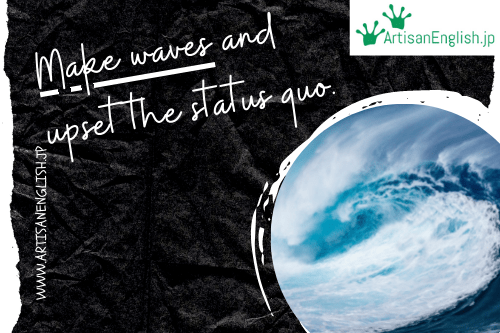
YouTube / iTunes / Spotify / Radio Public / Pocket Casts / Google Podcasts / Breaker / Overcast
Listen to ArtisanEnglish.jp posts & lesson intros here.
WotD: Make waves
It is time to make waves, disturb the status quo, and cause a little trouble.
Throughout history, innovations have changed the way we live and do business.
These innovations are designed with one goal in mind: to upset the apple cart.
Changing how we do things or causing trouble is what it means to make waves.
Making waves can be good or bad, depending on your point of view.
The list includes everything from railroads to the internet and airplanes to smartphones.
Innovations often make waves and are rarely welcomed without resistance.
Making waves is all about new and fresh ways of doing things.
We need to introduce new and innovative business ideas that will make waves and disturb the status quo.
One way to do this is by embracing change.
When people are in the habit of doing something in a certain way, they naturally resist change.
Often, the old ways require more effort but cause fewer mistakes, whereas innovations require less effort but more mistakes.
Sometimes that’s what’s needed to progress.
Some might think it’s easier to stick with the first one because it involves fewer mistakes.
Still, in the long run, the productivity increases of the second will be exponential, and the accuracy will improve.
Let’s call it short-term pain for long-term gain.
For example, the days of writers, and copywriters, in particular, are numbered.
With the advent of artificial intelligence (AI), we can see a future where AI assistants work independently to write ideas with the help of an expert when needed.
This does not mean humans will have no role in copywriting.
Creativity is still necessary for writing great content – so it’s unlikely that AI will ever replace humans altogether.
AI is and will continue to make waves in the copywriting field.
Flesch-Kincaid Readability Test
This post is understandable by someone with at least an 8th-grade education (age 13 – 14).
On the Flesch-Kincaid reading-ease test, this post scores 63.
The easier a passage is to read, the higher the score on a scale of 0 – 100.

